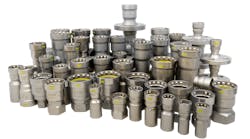YOU’D BETTER get over here right away, the water heater you installed almost burned down our house!” Now if those aren’t words that strike fear into your heart, I don’t know ones that will.
This was August 1982 in a new home we had recently completed and where we had installed several gas-fired appliances: a direct-vent, high-efficiency furnace; gas-log set; stove/oven; and the submerged-chamber chimney-vented water heater. The owners had moved in just a few months prior and had experienced no previous problems.
As I drove across town to the jobsite, I was racking my brain trying to figure out how a submerged-chamber style water heater could have possibly malfunctioned and caused the damage the owner had angrily described over the phone.
Once there, I was shocked to find the floor joists in this 9-ft. high basement were scorched and charred over a fairly wide area immediately above the water heater. The front of the water heater was also scorched and blackened from the fire, and the gas valve had obviously been toasted. The large plastic cover that had concealed the gas valve and combustion chamber was gone and, in its place, a black mass resembling a Salvador Dali painting was on the floor. The galvanized flue pipe was intact, being fastened at every joint with three self-tapping screws.
It didn’t help to have irate homeowners breathing down my neck as I searched for an answer to what happened. It was time to do some detective work!
First step – turn the gas back on and leak check all the joints. No leaks, which eliminated any potential defect in our workmanship. Although the water heater’s gas valve was damaged and needed to be replaced, I re-energized it to see if it would still function. I couldn’t get this darned thing to malfunction, even in its damaged state.
Now I was really scratching my head trying to figure out what the heck had caused this nearly catastrophic fire and, as you might expect, the homeowners were hinting about lawyers, damages and a new water heater.
By now you’ve probably figured out what was wrong in this home, but I was sweating bullets and not because it was a hot, humid August day. We had installed central air in this home and it dawned on me that it wasn’t running. When I asked why, the homeowners told me they seldom use their air conditioning because they have a whole-house fan the general contractor had installed several weeks after they had moved in. He had told them it would be much more economical to operate than the central air. Did they keep their basement door open or closed? Since they replied it was always closed, it seemed unlikely the whole-house fan could have caused a problem, but I was grasping at straws and willing to try just about anything.
Now bear in mind the following: The door to the basement is closed, the windows are all open and screened as are several doors, allowing free flow of incoming air on the upper floor. I asked that they turn on the fan.
As we stood there in front of the water heater, we could hear the upstairs hallway ceiling fan energize and I stared in abject fascination as we watched the water heater’s flame being gradually pulled out through the submerged combustion chamber! Within less than a minute the entire flame was now burning outside the water heater’s combustion chamber. No wonder the plastic cover had caught fire and sent flames racing up the front jacket to scorch the floor joists.
A set of double doors was only a few feet away in this basement, so we threw them open to allow the air pressure to equalize. No dice, the flames continued to roll out! Evidently the builder had installed a whole-house fan that was grossly oversized. I felt as if the weight of a thousand tons had been lifted from my shoulders.
Now that we weren’t the villains, the homeowners turned sweet as honey. A new gas valve was installed but not a second plastic cover. Not only were we off the hook, our time and materials were now billable! The owner’s crosshairs shifted to center squarely on the builder.
With homes today so tightly constructed, it’s no wonder that a whole-house fan can subject your equipment to adverse negative pressure. We’ve since seen a number of residential applications affected by negative air pressure and chased the ghosts of nuisance safety lockouts with vacuum/pressure switches, open circuits from flame roll-out sensors and CO detectors alerting homeowners that were related to this negative pressure syndrome. Selling and installing outdoor/indoor air-to-air heat exchangers opens up an opportunity to turn this problem into a profitable solution!
Dave Yates owns F.W. Behler, a contracting company in York, Pa. He can be reached by phone at 717/843-4920 or by e-mail at [email protected].

